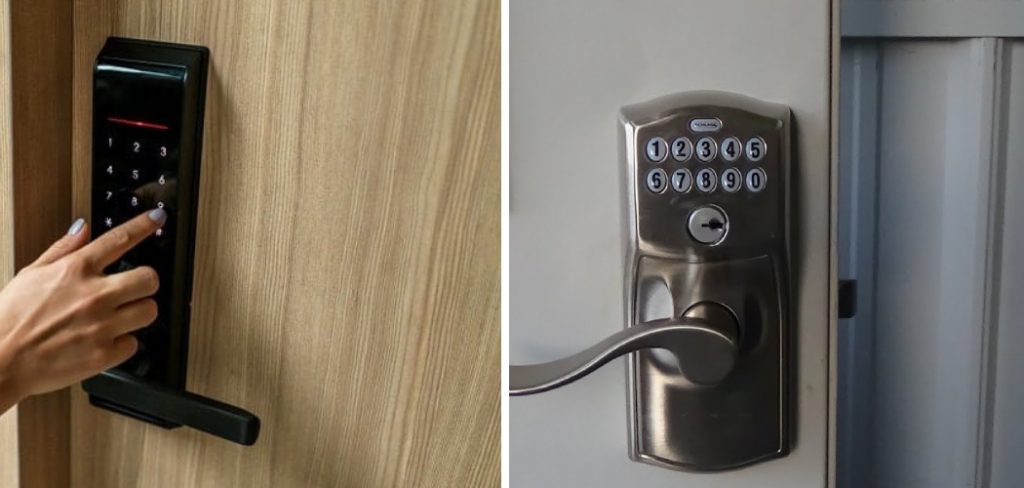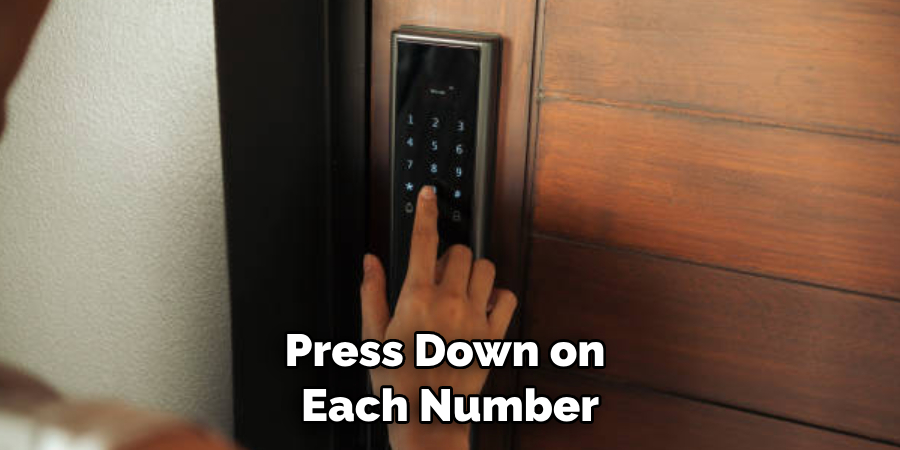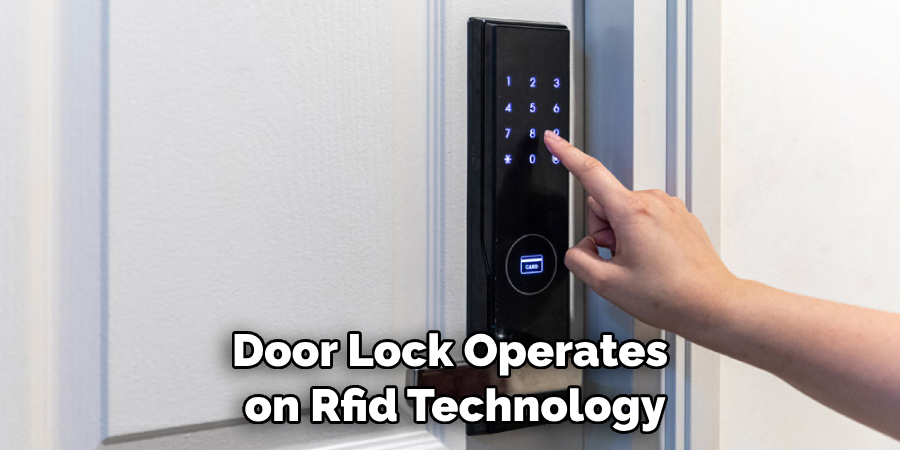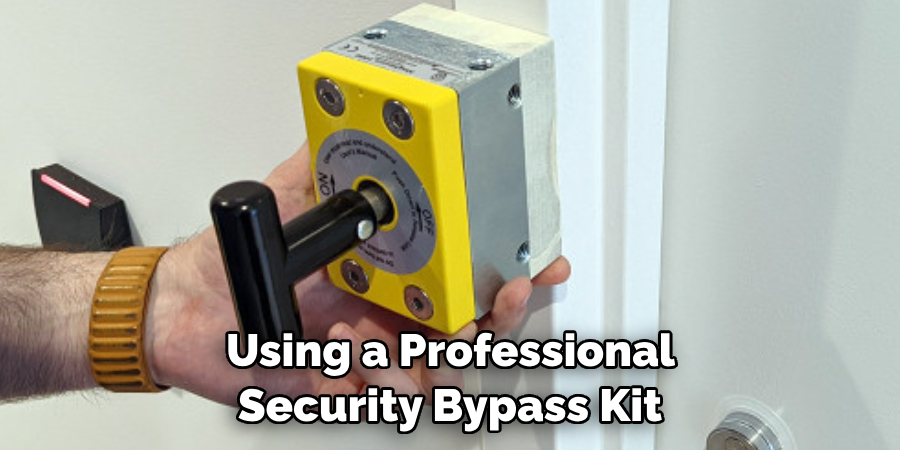Have you ever been locked out of somewhere important? Perhaps you need to remember the combination to your home’s keypad door lock, or you’re struggling to get into a vending machine. No matter what the reason, don’t worry!

If you’re looking for a way to bypass the keypad locks on your doors, you’ve come to the right place. Follow the steps below, and you can break into almost any keypad door lock.
In this blog post, we’ll look in-depth at how to hack a keypad door lock. We’ll review several techniques ranging from simpler low-tech methods to more advanced high-tech approaches and explain which is best suited for each situation. Are you ready? Let’s get started!
What Will You Need?
Before you start hacking a keypad door lock, you’ll need to gather some equipment. Depending on the method chosen, you might need tools such as:
- A pen or paper clip
- Lock picking tools
- A powerful magnet
- An RFID reader
- A laptop with special software installed
Once you’ve gathered everything, it’s time to move on to the next step.
8 Easy Steps on How to Hack a Keypad Door Lock
Step 1. Low-Tech Methods

The simplest and least intrusive way to hack a keypad door lock is with a pen or paper clip. Simply insert the thin metal item into the small hole near the keypad and press down on each number until you find the combination. This method is not foolproof, as not all locks respond to a paperclip, but it’s worth trying if you don’t have access to other tools.
Step 2. Using Lock Picking Tools
Lock picking tools can be a useful asset in your attempts to bypass a keypad door lock. With a tension wrench and a pick, you may be able to manipulate the lock’s pins, allowing the lock to open. You need to insert the tension wrench into the bottom of the keyhole and apply slight pressure, then use the pick to lift up the pins inside the lock. The lock should turn and unlock when all the pins are lifted correctly. Remember, this method requires some skill and patience, so practice on an old lock before trying it on an actual door.
Step 3. Using a Powerful Magnet
Some keypad locks, particularly electronic ones, can be overcome with a powerful magnet. This method uses the magnet to interfere with the lock’s mechanism, causing it to unlock. To apply this method, you hold the magnet close to the lock and move it around in a circular motion. Be aware that this method only works on some types of locks and may require several attempts. It’s also worth noting that using a magnet in this manner might damage electronic components, so it should be considered as a last resort.
Step 4. Using an RFID Reader
If the keypad door lock operates on RFID technology, an RFID reader could be a viable hacking method. RFID, which stands for radio frequency identification, uses electromagnetic fields to identify and track tags attached to objects automatically. In the case of an RFID lock, the tag would be the key.

To hack this type of lock, you would need to capture the RFID signal from a legitimate key and then replay that signal. You can use an RFID reader and a laptop with the appropriate software. This method is more complex and requires certain technical knowledge, but it can be very effective if executed correctly. Please note that this should only be used in ethical and legal situations.
Step 5. Using Specialized Software
If you are tech-savvy and the keypad door lock is a smart lock connected to a network, using specialized software could be your best bet. Certain software programs can exploit security vulnerabilities in a lock’s software, allowing you to bypass the lock. They work by mimicking legitimate signals or by sending commands directly to the lock. This method requires a deep understanding of network security and the specific software used. Always ensure that your actions are in line with legal and ethical guidelines.
Step 6. Resetting The Keypad
If hacking methods don’t seem to work, resetting the keypad lock may be an option. Many keypad locks have a reset button inside the door or a specific reset code that can be entered. Remember that this method is usually only possible if you have access to the other side of the door, but it can be an effective way to change the lock’s code and regain access. After resetting the lock, you can set a new code. Always make sure to remember or safely store the new code to prevent future lockouts.
Step 7. Using Security Bypass Kits
If all else fails and the situation is dire, you may consider using a professional security bypass kit. These kits are designed with various tools to help you unlock a keypad door lock. They contain advanced lock picking tools, decoding tools for specific lock brands, and tools to bypass various lock types, including electronic, mechanical, and combination locks.

Be sure to choose a kit that suits the type of lock you are dealing with. Remember that these kits should be used responsibly and ethically and are typically intended for professional locksmiths. It’s also important to remember that such tools can potentially damage the lock and should only be a last resort.
Step 8. Calling a Professional Locksmith
If none of the above methods work, your best option may be to call a professional locksmith. Experienced locksmiths have the knowledge and tools to unlock almost any type of keypad lock without causing damage. This can be particularly useful if the lock is of high value or installed on a door that would be expensive to repair or replace. However, while this method is the most effective, it can also be costly. Always hire a reputable locksmith and agree on the price before any work.
By following the steps above, you should be able to hack a keypad door lock. However, it is paramount to remember that these instructions are given for ethical and legal purposes only.
5 Additional Tips and Tricks
- Observe and Analyze: One of the most effective ways to ‘hack’ a keypad door lock is to observe the frequently used keys keenly. These keys might be slightly worn out or have fingerprint smudges.
- Try Common Patterns: People use common patterns or sequences to set passcodes. Try some of the most frequently used patterns, such as “1234”, “1111”, or “2580” (straight down the middle of the keypad).
- Listen to the Keypad: Some keypad door locks produce distinct sounds for each key. By listening carefully, you can identify some of the sounds and associate them with specific keys.
- Use a Keypad Overlay: Keypad overlays can capture the keys pressed by a legitimate user. These devices are placed over the real keypad and record the keys pressed.
- Leverage Technology: There are also technological tools available that can assist in hacking a keypad lock. For example, thermal cameras can detect heat signatures left by fingers on the keypad. However, such tools’ legality and ethical implications must be considered.
Remember, it’s crucial to respect others’ privacy and only use these methods for lawful and ethical purposes, like recovering your passcode.
5 Things You Should Avoid

- Avoid Rushing: Hacking a keypad door lock requires patience and careful observation. Hasty attempts might lead to errors or even alert others to your activities.
- Don’t Use Excessive Force: Applying excessive force to the keypad can cause it to malfunction or break, leading to costly repairs or even making it impossible to open the door from the outside.
- Avoid Predictable Patterns: If you can set the passcode, avoid easily predictable patterns like “1234” or “2580.” These are the first sequences that anyone trying to gain unauthorized access might attempt.
- Don’t Ignore Privacy Laws: It’s crucial to respect privacy laws and only attempt to hack a keypad door lock for legitimate reasons, such as forgetting your own passcode. Unauthorized attempts can lead to legal ramifications.
- Avoid Unethical Practices: While it’s possible to use technology such as keypad overlays or thermal cameras to hack a keypad door lock, it’s essential to consider the ethical implications. These methods should be reserved for authorized individuals only.
By avoiding unethical practices, not only are you respecting the rights of others, but you’re also preventing potential legal issues.
Conclusion
To wrap this blog post up, how to hack a keypad door lock is a relatively simple feat when one has the right tools and understanding of the process. Knowing how to hack or bypass any type of security system, including door locks, can come in handy when one can’t access their key or forget their code.
Furthermore, this newfound skill could spark an interest in technology and create an opportunity for learning more about computer science and cyber security. No matter the purpose of hacking a keypad door lock, it’s important to ensure that whatever methods are used are legal within one’s state.
Additionally, always use caution when trying to gain unauthorized access to a secure space, as such measures could carry criminal penalties depending on the situation. That said, remember that hacking can be fun if used responsibly!
About
Safety Fic is a distinguished figure in the world of Diy design, with a decade of expertise creating innovative and sustainable Diy solutions. His professional focus lies in merging traditional craftsmanship with modern manufacturing techniques, fostering designs that are both practical and environmentally conscious. As the author of diy, Safety Fic delves into the art and science of Safety Fic-making, inspiring artisans and industry professionals alike.
Education RMIT University
(Melbourne, Australia) Associate Degree in Design (Safety Fic) Focus on sustainable design, industry-driven projects, and practical craftsmanship. Gained hands-on experience with traditional and digital manufacturing tools, such as CAD and CNC software.
Nottingham Trent University
(United Kingdom) Bachelor’s in diyfastly.com and Product Design (Honors) Specialized in product design with a focus on blending creativity with production techniques. Participated in industry projects, working with companies like John Lewis and Vitsoe to gain real-world insights.
Publications and Impact
In diy, Safety Fic his insights on indoor design processes, materials, and strategies for efficient production. His writing bridges the gap between artisan knowledge and modern industry needs, making it a must-read for both budding designers and seasoned professionals.
